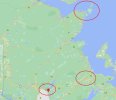I stumbled upon the following news item. Apparently in Acadian Peninsula and the Moncton region of New Brunswick there is an outbreak of a mysterious prion-like disease. The first case was registered in 2015, but now cases steadily increase. Forty-three cases have been identified, and five people have died.
What's ridiculous, that while Covid hysteria is rampant in Canada, this disease was totally "hush-hushed" until recently. And they still refuse to disclose the exact locations.
I tried looking if there was anything strange happening in the area, and there are some things that happend in New Brunswick, like mysterious booms here and here, but they happened after 2015 and not near both of the mentioned areas.
What's ridiculous, that while Covid hysteria is rampant in Canada, this disease was totally "hush-hushed" until recently. And they still refuse to disclose the exact locations.
N.B.'s mystery disease: What we know so far
What is it?
When was it discovered?
- An unknown neurological disease with similarities to Creutzfeldt-Jakob disease, a rare and fatal brain disease
When was it made public?
- A single case was diagnosed in 2015. Three years later, in 2019, 11 additional cases were discovered, with 24 more cases discovered in 2020 and another six in 2021. Five people have died.
Where are the cases?
- A March 5 internal memo from Public Health to health-care professionals was obtained by Radio-Canada and reported by Radio-Canada and CBC News on Wednesday, March 17.
How many cases are there?
- The disease has so far only been identified in New Brunswick. It appears to be concentrated on the Acadian Peninsula in northeast New Brunswick and the Moncton region in the southeast.
Who has been affected?
- Forty-three cases have been identified. Of those, 35 are on the Acadian Peninsula and eight are in the Moncton region.
What are the symptoms?
- The disease affects all age groups and affects males and females equally, according to the Public Health memo. About half of the affected individuals are between 50 and 69 years of age.
Is it contagious?
- Symptoms include changes in behaviour, sleep disturbances, unexplained pain, visual hallucinations, co-ordination problems and severe muscle and brain atrophy.
What are the possible causes being researched?
- Because the cause has not been determined, it is not yet known whether the disease is contagious.
Who's researching it?
- Despite many similarities, tests for Creutzfeldt-Jakob disease have so far ruled out known prion diseases.
- Scientists are currently looking into the possibility that this is a new variant of a prion disease — or a new disease entirely.
- Neurologists and scientists suspect the cause might be exposure to an as-yet-undetermined environmental toxin.
- The disease is the subject of investigation by an all-Canadian team of neurologists, epidemiologists, scientists, researchers and other experts.
- Here in New Brunswick, Moncton neurologist Dr. Alier Marrero is leading the research. In Ottawa, senior scientist and Creutzfeldt-Jakob Disease Surveillance System director Michael Coulthart is leading the research.
I tried looking if there was anything strange happening in the area, and there are some things that happend in New Brunswick, like mysterious booms here and here, but they happened after 2015 and not near both of the mentioned areas.




